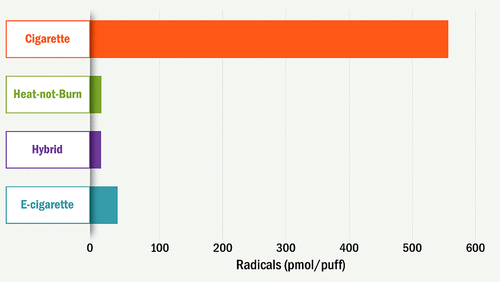当前位置:
X-MOL 学术
›
Chem. Res. Toxicol.
›
论文详情
Our official English website, www.x-mol.net, welcomes your feedback! (Note: you will need to create a separate account there.)
Free Radical Production and Characterization of Heat-Not-Burn Cigarettes in Comparison to Conventional and Electronic Cigarettes.
Chemical Research in Toxicology ( IF 4.1 ) Pub Date : 2020-05-20 , DOI: 10.1021/acs.chemrestox.0c00088 Zachary T Bitzer 1 , Reema Goel 1 , Neil Trushin 1 , Joshua Muscat 1 , John P Richie 1
Chemical Research in Toxicology ( IF 4.1 ) Pub Date : 2020-05-20 , DOI: 10.1021/acs.chemrestox.0c00088 Zachary T Bitzer 1 , Reema Goel 1 , Neil Trushin 1 , Joshua Muscat 1 , John P Richie 1
Affiliation

|
With conventional cigarettes, the burning cone reaches temperatures of >900 °C, resulting in the production of numerous toxicants and significant levels of highly reactive free radicals. In attempts to eliminate combustion while still delivering nicotine and flavorings, a newer alternative tobacco product has emerged known as “heat-not-burn” (HnB). These products heat tobacco to temperatures of 250–350 °C depending on the device allowing for the volatilization of nicotine and flavorants while potentially limiting the production of combustion-related toxicants. To better understand how the designs of these new products compare to conventional cigarettes and different styles of electronic cigarettes (e-cigs), we measured and partially characterized their production of free radicals. Smoke or aerosols were trapped by a spin trap phenyl-N-tert-butylnitrone (PBN) and analyzed for free radicals using electron paramagnetic resonance (EPR). Free radical polarity was assessed by passing the aerosol or smoke through either a polar or nonpolar trap prior to being spin trapped with PBN. Particulate-phase radicals were detected only for conventional cigarettes. Gas-phase free radicals were detected in smoke/aerosol from all products with levels for HnB (IQOS, Glo) (12 pmol/puff) being similar to e-cigs (Juul, SREC, box mod e-cig) and hybrid devices (Ploom) (5–40 pmol/puff) but 50-fold lower than conventional cigarettes (1R6F). Gas phase radicals differed in polarity with HnB products and conventional cigarettes producing more polar radicals compared to those produced from e-cigs. Free radical production should be considered in evaluating the toxicological profile of nicotine delivery products and identification of the radicals is of paramount importance.
中文翻译:

与传统卷烟和电子卷烟相比,加热不燃烧卷烟的自由基产生和表征。
对于传统卷烟,燃烧锥的温度达到 >900 °C,导致产生大量有毒物质和大量高活性自由基。为了在消除燃烧的同时仍能提供尼古丁和调味剂,出现了一种新的替代烟草产品,称为“加热不燃烧”(HnB)。这些产品将烟草加热到 250–350 °C 的温度,具体取决于允许尼古丁和调味剂挥发的装置,同时可能限制与燃烧相关的有毒物质的产生。为了更好地了解这些新产品的设计与传统香烟和不同风格的电子香烟 (e-cigs) 相比如何,我们测量并部分表征了它们的自由基产生。烟雾或气溶胶被自旋捕集器捕集苯基-N-叔_-丁基硝酮 (PBN) 并使用电子顺磁共振 (EPR) 分析自由基。在被 PBN 自旋捕获之前,通过使气溶胶或烟雾通过极性或非极性陷阱来评估自由基极性。仅在传统卷烟中检测到颗粒相自由基。在所有产品的烟雾/气溶胶中检测到气相自由基,HnB (IQOS, Glo) (12 pmol/puff) 水平与电子烟 (Juul, SREC, box mod e-cig) 和混合设备 ( Ploom) (5–40 pmol/puff) 但比传统卷烟 (1R6F) 低 50 倍。与电子烟产生的相比,HnB 产品和传统香烟产生的极性自由基更多,气相自由基的极性不同。
更新日期:2020-07-20
中文翻译:

与传统卷烟和电子卷烟相比,加热不燃烧卷烟的自由基产生和表征。
对于传统卷烟,燃烧锥的温度达到 >900 °C,导致产生大量有毒物质和大量高活性自由基。为了在消除燃烧的同时仍能提供尼古丁和调味剂,出现了一种新的替代烟草产品,称为“加热不燃烧”(HnB)。这些产品将烟草加热到 250–350 °C 的温度,具体取决于允许尼古丁和调味剂挥发的装置,同时可能限制与燃烧相关的有毒物质的产生。为了更好地了解这些新产品的设计与传统香烟和不同风格的电子香烟 (e-cigs) 相比如何,我们测量并部分表征了它们的自由基产生。烟雾或气溶胶被自旋捕集器捕集苯基-N-叔_-丁基硝酮 (PBN) 并使用电子顺磁共振 (EPR) 分析自由基。在被 PBN 自旋捕获之前,通过使气溶胶或烟雾通过极性或非极性陷阱来评估自由基极性。仅在传统卷烟中检测到颗粒相自由基。在所有产品的烟雾/气溶胶中检测到气相自由基,HnB (IQOS, Glo) (12 pmol/puff) 水平与电子烟 (Juul, SREC, box mod e-cig) 和混合设备 ( Ploom) (5–40 pmol/puff) 但比传统卷烟 (1R6F) 低 50 倍。与电子烟产生的相比,HnB 产品和传统香烟产生的极性自由基更多,气相自由基的极性不同。


























 京公网安备 11010802027423号
京公网安备 11010802027423号